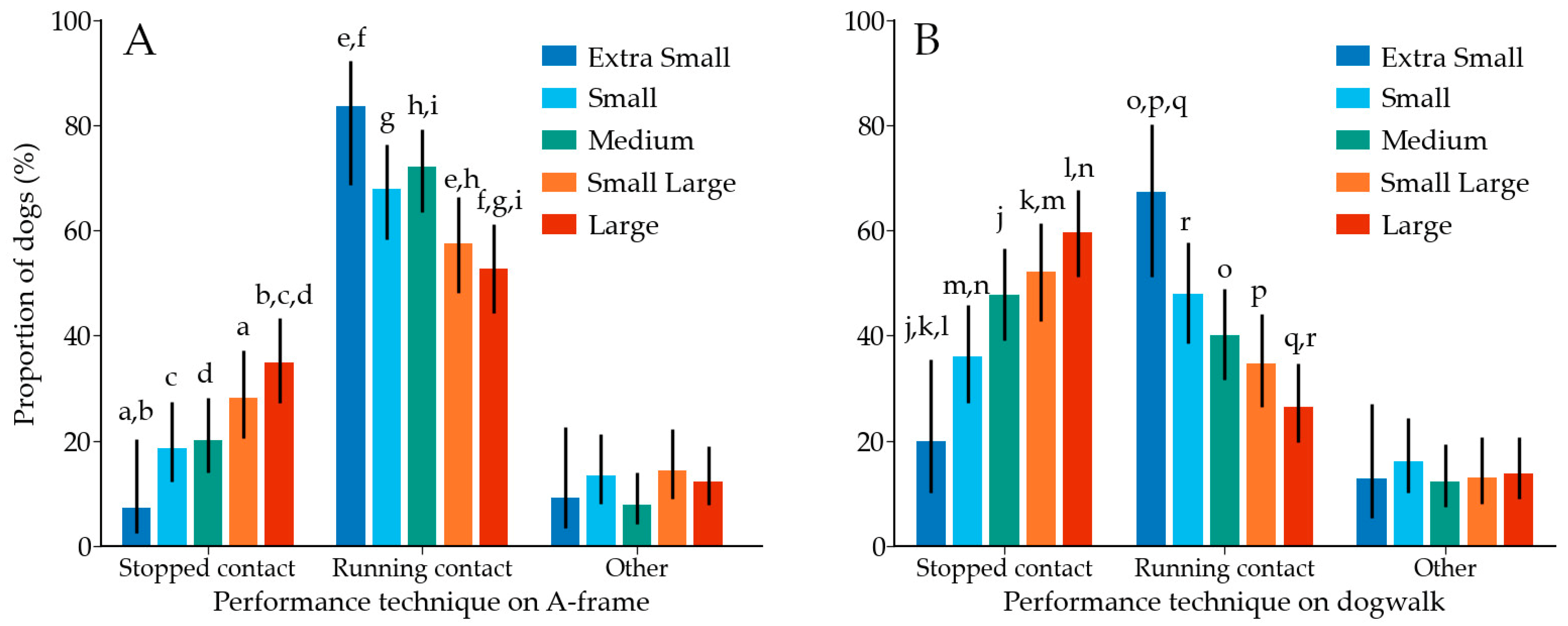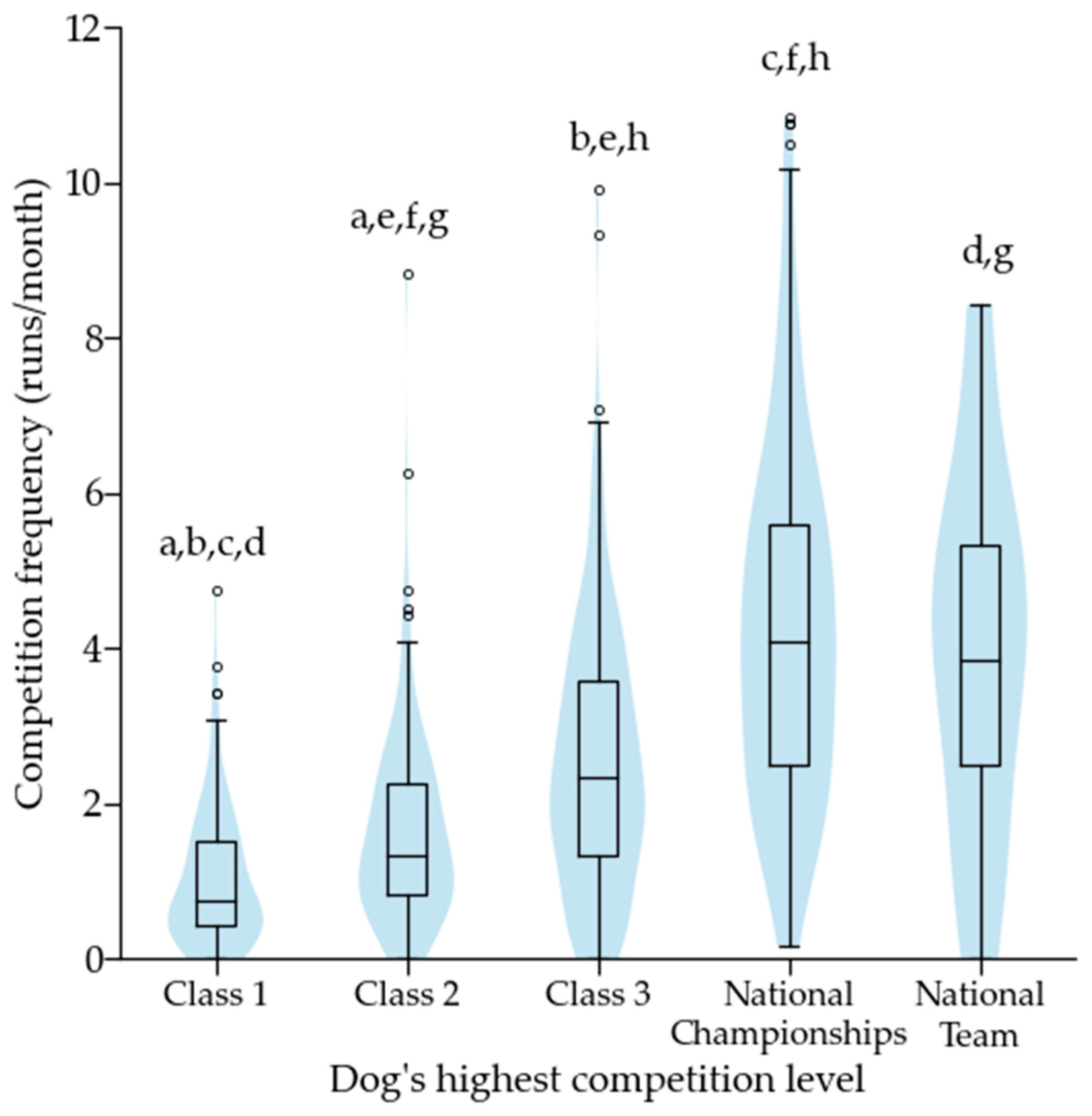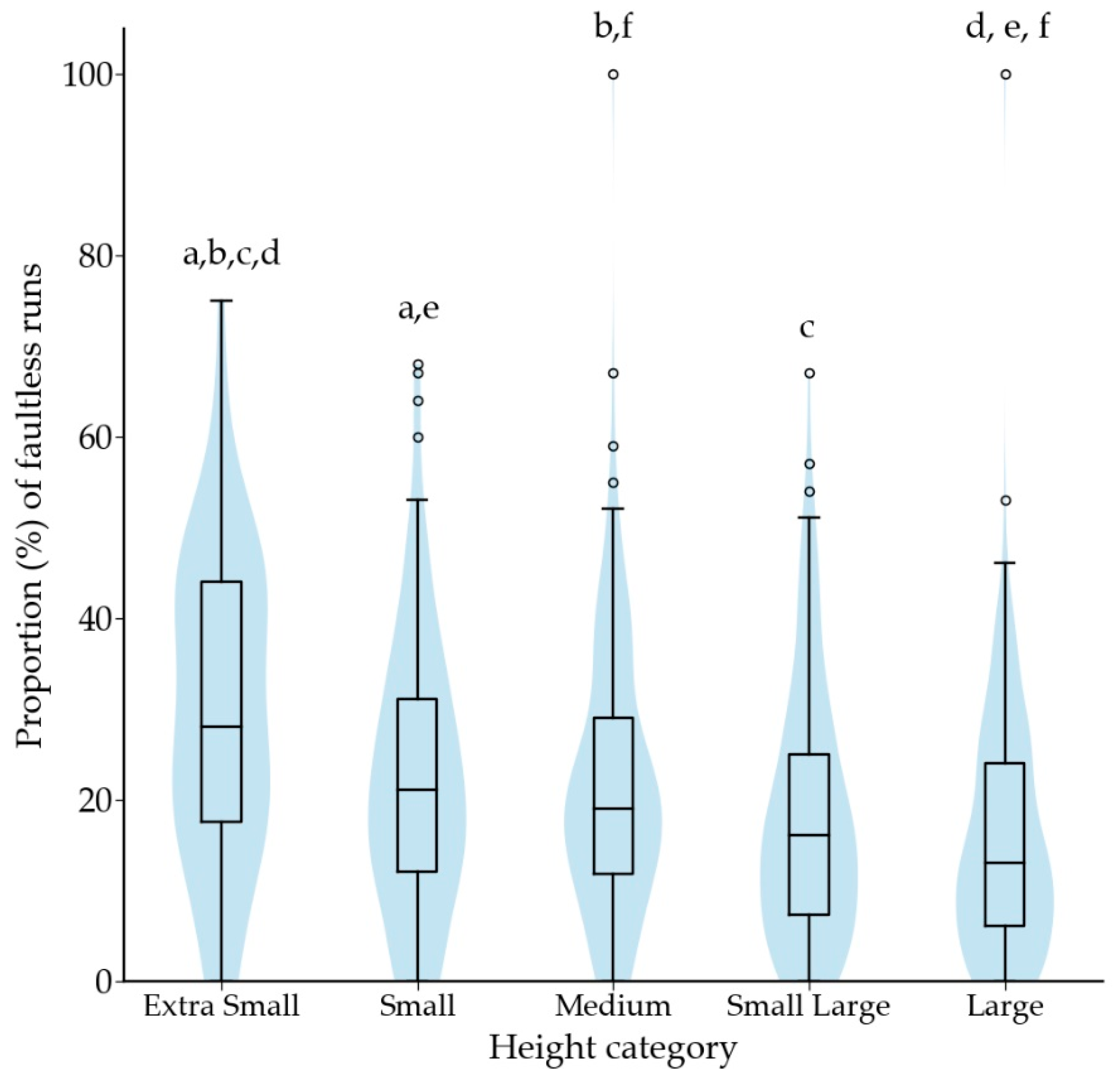Part I of Finnish Agility Dog Survey: Training and Management of Competition-Level Agility Dogs
Abstract
Simple Summary
Abstract
1. Introduction
2. Materials and Methods
2.1. Dogs and Respondents
2.2. Questionnaire
2.3. Competition Results Database
2.4. Data Curation
2.5. Data Analysis and Statistical Methods
3. Results
3.1. Dogs and Respondents
Dog’s and Main Handler’s Experience in Agility
3.2. Training, Competition, and Management Routines during 2019
3.2.1. Agility Training
3.2.2. Competition
3.2.3. Field Surface
3.2.4. Time off from Agility
3.2.5. Warm-Up and Cool-Down
3.2.6. Musculoskeletal Care and Conditioning
3.2.7. Daily Exercise
3.3. Health History
4. Discussion
5. Conclusions
Supplementary Materials
Author Contributions
Funding
Institutional Review Board Statement
Informed Consent Statement
Data Availability Statement
Acknowledgments
Conflicts of Interest
References
- Cullen, K.L.; Dickey, J.P.; Bent, L.R.; Thomason, J.J.; Moëns, N.M.M. Internet-Based Survey of the Nature and Perceived Causes of Injury to Dogs Participating in Agility Training and Competition Events. J. Am. Vet. Med. Assoc. 2013, 243, 1010–1018. [Google Scholar] [CrossRef]
- Levy, I.; Hall, C.; Trentacosta, N.; Percival, M. A Preliminary Retrospective Survey of Injuries Occurring in Dogs Participating in Canine Agility. Vet. Comp. Orthop. Traumatol. 2009, 22, 321–324. [Google Scholar]
- Tarkempia Tietoja 2018 Sääntöuudistuksesta. Available online: https://www.agilityliitto.fi/uutiset/tarkempia-tietoja-2018-saantouudistuksesta/ (accessed on 15 October 2021).
- Kerr, Z.Y.; Fields, S.; Comstock, R.D. Epidemiology of Injury among Handlers and Dogs Competing in the Sport of Agility. J. Phys. Act. Health 2014, 11, 1032–1040. [Google Scholar] [CrossRef] [PubMed]
- Dinallo, G.K.; Poplarski, J.A.; van Deventer, G.M.; Eirmann, L.A.; Wakshlag, J.J. A Survey of Feeding, Activity, Supplement Use and Energy Consumption in North American Agility Dogs. J. Nutr. Sci. 2017, 6, e45. [Google Scholar] [CrossRef] [PubMed][Green Version]
- Palmer, A.L.; Bolwell, C.F.; Stafford, K.J.; Gal, A.; Rogers, C.W. Patterns of Racing and Career Duration of Racing Greyhounds in New Zealand. Animals 2020, 10, 796. [Google Scholar] [CrossRef]
- Palmer, A.L.; Rogers, C.W.; Stafford, K.J.; Gal, A.; Cochrane, D.J.; Bolwell, C.F. Cross-Sectional Survey of the Training Practices of Racing Greyhounds in New Zealand. Animals 2020, 10, 2032. [Google Scholar] [CrossRef]
- Windred, A.J.; Osmotherly, P.G.; Mcgowan, C.M. Pre-Race Warm-up Practices in Greyhound Racing: A Pilot Study. Equine Comp. Exerc. Physiol. 2007, 4, 119–122. [Google Scholar] [CrossRef]
- Cullen, K.L.; Dickey, J.P.; Bent, L.R.; Thomason, J.J.; Moëns, N.M.M. Survey-Based Analysis of Risk Factors for Injury among Dogs Participating in Agility Training and Competition Events. J. Am. Vet. Med. Assoc. 2013, 243, 1019–1024. [Google Scholar] [CrossRef]
- Inkilä, L.; Hyytiäinen, H.; Hielm-Björkman, A.; Junnila, J.; Bergh, A.; Boström, A. Part II of Finnish Agility Dog Survey: Agility-Related Injuries and Risk Factors for Injury in Competition-Level Agility Dogs. Animals, 2022, in press.
- Willis, G.B.; Artino, A.R. What Do Our Respondents Think We’re Asking? Using Cognitive Interviewing to Improve Medical Education Surveys. J. Grad. Med. Educ. 2013, 5, 353–356. [Google Scholar] [CrossRef]
- Wenemark, M. Enkätmetodik Med Respondenten i Fokus, 1st ed.; Studentlitteratur AB: Lund, Sweden, 2017; pp. 170–172. [Google Scholar]
- Verhoeven, G.; Ecvs, D.; Fortrie, R.; van Ryssen, B.; Coopman, F. Worldwide Screening for Canine Hip Dysplasia: Where Are We Now? Vet. Surg. 2012, 41, 10–19. [Google Scholar] [CrossRef] [PubMed]
- Ohje Polvilumpioluksaation Tutkimuksesta Ja Luokituksesta. Available online: https://www.kennelliitto.fi/lomakkeet/ohje-polvilumpioluksaation-tutkimisesta-ja-luokituksesta-polvilumpioluksaatio-ohje (accessed on 4 August 2021).
- Finnish Kennel Club Requirements for Spinal Radiography and Grading of Spinal Changes. Available online: https://www.kennelliitto.fi/en/forms/spinal-radiography-and-grading-spinal-changes (accessed on 4 August 2021).
- Lappalainen, A.K.; Mölsä, S.; Liman, A.; Snellman, M.; Laitinen-Vapaavuori, O. Evaluation of Accuracy of the Finnish Elbow Dysplasia Screening Protocol in Labrador Retrievers. J. Small Anim. Pract. 2013, 54, 195–200. [Google Scholar] [CrossRef]
- Zink, C.; Carr, B.J. Conditioning and Retraining the Canine Athlete. In Canine Sports Medicine and Rehabilitation, 2nd ed.; Zink, C., van Dyke, J.B., Eds.; John Wiley & Sons, Inc.: Hoboken, NJ, USA, 2018; pp. 245–250 and 259–260. [Google Scholar]
- Birch, E.; Leśniak, K. Effect of Fence Height on Joint Angles of Agility Dogs. Vet. J. 2013, 198, e99–e102. [Google Scholar] [CrossRef] [PubMed]
- Steiss, J.E. Muscle Disorders and Rehabilitation in Canine Athletes. Vet. Clin. Small Anim. Pract. 2002, 32, 267–285. [Google Scholar] [CrossRef]
- Fuglsang-Damgaard, L.H.; Harrison, A.P.; Vitger, A.D. Altered Muscle Activation in Agility Dogs Performing Warm-up Exercises: An Acoustic Myography Study. Comp. Exerc. Physiol. 2021, 17, 251–261. [Google Scholar] [CrossRef]
- Cullen, K.L.; Dickey, J.P.; Brown, S.H.M.; Nykamp, S.G.; Bent, L.R.; Thomason, J.J.; Moens, N.M.M. The Magnitude of Muscular Activation of Four Canine Forelimb Muscles in Dogs Performing Two Agility-Specific Tasks. BMC Vet. Res. 2017, 13, 68. [Google Scholar] [CrossRef]
- Herman, K.; Barton, C.; Malliaras, P.; Morrissey, D. The Effectiveness of Neuromuscular Warm-up Strategies, That Require No Additional Equipment, for Preventing Lower Limb Injuries during Sports Participation: A Systematic Review. BMC Med. 2012, 10, 75. [Google Scholar] [CrossRef]
- Emery, C.A.; Meeuwisse, W.H. The Effectiveness of a Neuromuscular Prevention Strategy to Reduce Injuries in Youth Soccer: A Cluster-Randomised Controlled Trial. Br. J. Sports Med. 2010, 44, 555–562. [Google Scholar] [CrossRef] [PubMed]
- Thorborg, K.; Kühn Krommes, K.; Esteve, E.; Bek Clausen, M.; Marie Bartels, E.; Skovdal Rathleff, M. Effect of Specific Exercise-Based Football Injury Prevention Programmes on the Overall Injury Rate in Football: A Systematic Review and Meta-Analysis of the FIFA 11 and 11+ Programmes. Br. J. Sports Med. 2017, 51, 562–571. [Google Scholar] [CrossRef] [PubMed]
- Taylor, J.B.; Waxman, J.P.; Richter, S.J.; Shultz, S.J. Evaluation of the Effectiveness of Anterior Cruciate Ligament Injury Prevention Programme Training Components: A Systematic Review and Meta-Analysis. Br. J. Sports Med. 2015, 49, 79–87. [Google Scholar] [CrossRef] [PubMed]
- van Reijen, M.; Vriend, I.; van Mechelen, W.; Finch, C.F.; Verhagen, E.A. Compliance with Sport Injury Prevention Interventions in Randomised Controlled Trials: A Systematic Review. Sports Med. 2016, 46, 1125–1139. [Google Scholar] [CrossRef] [PubMed]
- Edge-Hughes, L. Canine treatment and rehabilitation for orthopaedic conditions. In Animal Physiotherapy: Assessment, Treatment and Rehabilitation of Animals, 2nd ed.; Goff, L., McGowan, C., Eds.; Wiley-Blackwell: Oxford, UK, 2016; p. 259. [Google Scholar]
- Helton, W.S. Skill in Expert Dogs. J. Exp. Phychol. Appl. 2007, 13, 171–178. [Google Scholar] [CrossRef][Green Version]
- Söhnel, K.; Rode, C.; de Lussanet, M.H.E.; Wagner, H.; Fischer, M.S.; Andrada, E. Limb Dynamics in Agility Jumps of Beginner and Advanced Dogs. J. Exp. Biol. 2020, 223, jeb202119. [Google Scholar] [CrossRef]
- Birch, E.; Carter, A.; Boyd, J. An Examination of Jump Kinematics in Dogs over Increasing Hurdle Heights. Comp. Exerc. Physiol. 2016, 12, 91–98. [Google Scholar] [CrossRef]
- Pfau, T.; Garland de Rivaz, A.; Brighton, S.; Weller, R. Kinetics of Jump Landing in Agility Dogs. Vet. J. 2011, 190, 278–283. [Google Scholar] [CrossRef] [PubMed]
- Hudson, P.E.; Corr, S.A.; Wilson, A.M. High Speed Galloping in the Cheetah (Acinonyx Jubatus) and the Racing Greyhound (Canis Familiaris): Spatio-Temporal and Kinetic Characteristics. J. Exp. Biol. 2012, 215, 2425–2434. [Google Scholar] [CrossRef]
- Larson, R.B. Controlling Social Desirability Bias. Int. J. Res. Mark. 2019, 61, 534–547. [Google Scholar] [CrossRef]
- Richman, W.L.; Weisband, S.; Kiesler, S.; Drasgow, F. A Meta-Analytic Study of Social Desirability Distortion in Computer-Administered Questionnaires, Traditional Questionnaires, and Interviews. J. Appl. Psychol. 1999, 84, 754–775. [Google Scholar] [CrossRef]









| Category | Variable |
|---|---|
| Signalment of the dog | Age 1 Breed Gender Weight Height Height category 2 Weight/height ratio 1 |
| Agility experience of the dog | Highest competition level Competition years in agility 1 Age at which course-like training started Age at which jumps were set at competition height Age at first competition |
| Main handler | Years of experience in agility Highest competition level (with any dog) |
| Health history | Number of previous agility-related injuries 1 Non-agility-related musculoskeletal injuries (yes/no) Any of the following musculoskeletal diseases (yes/no): Hip dysplasia (grade C 3,4 or worse, or diagnosis by veterinarian) |
| Patellar luxation (grade 1 3,5 or worse, or diagnosis by veterinarian) 8 Lumbosacral transitional vertebra (LTV; grade 1 3,6 or worse, or diagnosis by veterinarian) Elbow disease (grade 1 3,7 or worse elbow dysplasia, or diagnosis by veterinarian) Osteochondrosis/osteochondritis dissecans (OC[D]; diagnosis by veterinarian) 8 Injury of the biceps tendon or muscle (diagnosis by veterinarian) 8 Injury of supraspinatus muscle or tendon (diagnosis by veterinarian) 8 Shoulder instability/medial shoulder syndrome (diagnosis by veterinarian) 8 Fracture (diagnosis by veterinarian) 8 Other muscle injury (diagnosis by veterinarian) 8 Carpal sprain (diagnosis by veterinarian) 1,8 Sprain of a toe (diagnosis by veterinarian) 1,8 |
| Category | Variable |
|---|---|
| Training | Frequency of training sessions (average number of sessions per week) 1 Training session duration (average active training time per session in minutes) 1 Weekly total training time (active training time during active training weeks in minutes, excluding weeks off from agility) 2 Main field surface used in training and competitions 1 Relative fence height in training (typical fence height in relation to the dog’s height at withers) 2 Time off from agility 1 |
| Competition 3 | Competition frequency (average number of competition runs per month) Mean competition speed of faultless runs (m/s) 4 Proportion of faultless runs 4 Maximum relative fence height in competitions (maximum fence height in relation to the dog’s height at withers) 2 |
| Combined training and competition | Performance technique of A-frame and dogwalk 5 Weekly active agility time (minutes per week) 2 |
| Warm-up and cool-down 6 | Warm-up (yes/no) Duration of warm-up (average in minutes) Content of typical warm-up Cool-down (yes/no) Duration of cool-down (average in minutes) Content of typical cool-down |
| Musculoskeletal care | Frequency of visits to physiotherapist, massage therapist, osteopath and other professional Regular musculoskeletal care 2,7 |
| Exercise and conditioning | Conditioning (exercises to improve strength, speed, endurance or body control) (yes/no, frequency) 3 Duration of daily exercise (average total duration in hours and minutes) Participation in other physically demanding sports (e.g., herding or canicross) |
| Surface | Winter Season (n = 732) | Summer Season (n = 702) |
|---|---|---|
| Artificial turf with rubber filling | 47.8% | 27.2% |
| Dirt or sand | 10.7% | 45.6% |
| Artificial turf without filling | 21.3% | 12.4% |
| Artificial turf with cork filling | 14.3% | 8.7% |
| Artificial turf with sand filling | 1.6% | 1.6% |
| Natural grass | 0.0% | 3.4% |
| Horse riding surface | 1.8% | 0.9% |
| Fibre-sand mix | 2.3% | 0.1% |
| Rubber mat | 0.1% | 0.1% |
| Other | 0.0% | 0.1% |
| Reason | Winter Season (n = 384) | Summer Season (n = 332) |
|---|---|---|
| Planned break (e.g., periodisation of training) | 60.4% | 60.2% |
| Reason unrelated to the dog | 28.9% | 34.3% |
| Other dog-related reason | 15.4% | 14.8% |
| Previous injury or illness of the dog | 9.6% | 9.3% |
| Unknown | 0.8% | 0.3% |
| Item | Warm-Up (n = 744) | Cool-Down (n = 744) |
|---|---|---|
| Exercising on leash | 92.9% | 93.4% |
| Exercising off leash | 58.3% | 57.0% |
| Walking | 67.5% | 70.8% |
| Running | 72.8% | 51.1% |
| Sprinting | 38.6% | 2.6% |
| Tricks | 67.2% | 5.1% |
| Active stretches | 28.2% | 7.0% |
| Passive stretches | 10.2% | 5.2% |
| Tug play | 34.3% | 3.5% |
| Habituation to the field surface | 30.8% | Not applicable |
| Obstacle performances as part of warm-up | 25.7% | Not applicable |
| Other 1 | 2.6% | 1.9% |
| Professional | At Least Oncea Month | Every Two to Three Months | Less Often | Not at all |
|---|---|---|---|---|
| Massage therapist | 11.4% | 26.6% | 29.0% | 33.0% |
| Physiotherapist | 4.8% | 19.5% | 27.8% | 47.9% |
| Osteopath | 0.9% | 10.1% | 16.5% | 72.5% |
| Other | 4.0% | 6.6% | 5.6% | 83.8% |
| Diagnosis | Number of Dogs | Proportion of Dogs |
|---|---|---|
| Lumbosacral transitional vertebra | 89/745 | 11.9% |
| Hip dysplasia | 84/745 | 11.3% |
| Disease of the elbow | 23/745 | 3.1% |
| Fracture | 21/742 | 2.8% |
| Other muscle injury | 20/717 | 2.8% |
| Patellar luxation | 11/744 | 1.5% |
| Osteochondrosis/osteochondritis dissecans | 8/745 | 1.1% |
| Injury of biceps tendon or muscle | 5/743 | 0.7% |
| Injury of the iliopsoas muscle | 4/745 | 0.5% |
| Other tendon injury | 6/743 | 0.8% |
| Cranial cruciate tear | 3/745 | 0.4% |
| Luxation of the superficial digital flexor tendon | 3/745 | 0.4% |
| Carpal sprain | 2/741 | 0.3% |
| Sprain of digit | 2/740 | 0.3% |
| Osteoarthritis | 2/743 | 0.3% |
| Spondylosis | 2/745 | 0.3% |
| Shoulder instability/medial shoulder syndrome | 1/745 | 0.1% |
Publisher’s Note: MDPI stays neutral with regard to jurisdictional claims in published maps and institutional affiliations. |
© 2022 by the authors. Licensee MDPI, Basel, Switzerland. This article is an open access article distributed under the terms and conditions of the Creative Commons Attribution (CC BY) license (https://creativecommons.org/licenses/by/4.0/).
Share and Cite
Inkilä, L.; Hyytiäinen, H.K.; Hielm-Björkman, A.; Junnila, J.; Bergh, A.; Boström, A. Part I of Finnish Agility Dog Survey: Training and Management of Competition-Level Agility Dogs. Animals 2022, 12, 212. https://doi.org/10.3390/ani12020212
Inkilä L, Hyytiäinen HK, Hielm-Björkman A, Junnila J, Bergh A, Boström A. Part I of Finnish Agility Dog Survey: Training and Management of Competition-Level Agility Dogs. Animals. 2022; 12(2):212. https://doi.org/10.3390/ani12020212
Chicago/Turabian StyleInkilä, Leena, Heli K. Hyytiäinen, Anna Hielm-Björkman, Jouni Junnila, Anna Bergh, and Anna Boström. 2022. "Part I of Finnish Agility Dog Survey: Training and Management of Competition-Level Agility Dogs" Animals 12, no. 2: 212. https://doi.org/10.3390/ani12020212
APA StyleInkilä, L., Hyytiäinen, H. K., Hielm-Björkman, A., Junnila, J., Bergh, A., & Boström, A. (2022). Part I of Finnish Agility Dog Survey: Training and Management of Competition-Level Agility Dogs. Animals, 12(2), 212. https://doi.org/10.3390/ani12020212






